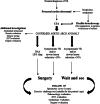Long term respiratory morbidity in patients with vascular rings: a review
- PMID: 36797770
- PMCID: PMC9936697
- DOI: 10.1186/s13052-023-01430-x
Long term respiratory morbidity in patients with vascular rings: a review
Abstract
Abnormalities in position and/or branching of the aortic arch can lead to vascular rings that may cause narrowing of the tracheal lumen due to external compression, or constriction of the oesophagus, causing symptoms that vary in relation to the anatomical vascular pattern and the relationship between these structures. Respiratory morbidity related to external airways compression is a major concern in children affected by vascular rings. Clinical presentation depends on the severity of the tracheal lumen reduction and the presence of associated tracheomalacia. Recurrent respiratory infections, wheezing, atelectasis, and hyperinflation are mostly reported. As they are nonspecific and therefore difficult to recognize, attention should be given to all children with history of respiratory distress, extubation failure, noisy breathing, and recurrent respiratory infections. Early diagnosis and referral to specialized centres can prevent the long-term complications and improve the respiratory outcomes of these patients.
Keywords: Airway compression; Children; Complete vascular rings; Incomplete vascular ring; Tracheomalacia.
© 2023. The Author(s).
Conflict of interest statement
The authors declare that they have no competing interests.
Figures






References
Publication types
MeSH terms
LinkOut - more resources
Full Text Sources
Research Materials

